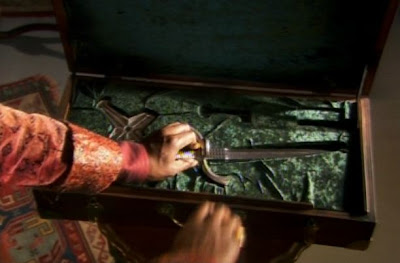
So, is there anyone who doesn't like Toy Story?
I first came across it in January 1996, on a VHS cassette while working at the BBC. The comp tape contained about an hour of trailers for all the upcoming movies that would be released throughout that year, and Toy Story grabbed me immediately. (NB. The tape had come free with Empire magazine)
That was a definitive example of advertising doing its job on me. I duly went to see the film at the cinema, loved every single frame of it, and like so many other 25-year-olds (or thereabouts) bought the full-length VHS of it for my mum at Christmas.

She loved it too.
For me, the one and only fly in the ointment of that first movie was Tim Allen as Buzz Lightyear. Not to subtract anything from Mr Allen's achievements, but he spent the entire film doing an impression of William Shatner. If that's what the director wanted, then surely a better choice would have been William Shatner?
(Allen continued this career-path in Galaxy Quest and Buzz Lightyear Of Star Command, which even included Shatner himself singing!)
In 1999 Toy Story 2 came out, and I was determined to make sure that I saw it properly. I think I'm right in saying that it was the first full-length movie to be wholly realised on computer. By this I mean that even the version I had watched of Toy Story 1 had been projected from a film print, but 2 was actually showing in the first and then only UK cinema to have a digital projector. The big one in Leicester Square, London.

It was a funny peculiar thing - I knew that there could be no possible blemish anywhere in the image, so obviously I just had to look for it anyway.
Since all my friends knew what a love I had of the film medium, it was with some irony that I had to admit afterwards that the crisp digital motion picture had actually drawn a tear from me, although I think that was more down to Disney. Jessie's previous owner - so sad.
Ten years on, in a country full of cinemas with digital projectors, I was similarly determined to experience Toy Story 3 in 3D. I was gutted to have missed the 3D re-releases of the first two, but kept checking the IMAX listings just to make sure that I hadn't missed out on seeing the threequel in the best possible version.
Well, I wound up leaving it too late for that as well.
On 16th October last year I bumped into Perry on the last train home. After disembarking, I told him that I was going to see Toy Story 3 that week. He asked me why I - a 39-year-old - was going to see a kids’ film. I said that it was actually a family film. He said that that was what the film-makers wanted me to think. I said “Getting older should enable you to do more things, not less. You should never lose the ability to enjoy a Disney movie.” He acquiesced. I never saw him again.
Two days later I sat in a theatre in Wandsworth, alone but for two small families somewhere behind me, and settled down to enjoy what I'd been waiting a decade for - another crazy adventure with Woody, Buzz and the rest.
It was everything I'd hoped for, and it was a long time before I got around to starting on my snacks. It amazes me that they can command moments of such powerful drama using a story about plastic toys, approximated on a computer.

Early this year we watched it again on my mum's latest DVD, and I still loved every moment of it, including the elements that had passed me by in the cinema, like their all getting to be played with by Andy one last time.
Let's be honest here, in different hands this trilogy could all have been so bland and unimaginative. How easy would it have been last century to knock off a script about toys simply going to work, getting married and having kids? Such shallow fables were not for Pixar in this instance, who instead sat down and worked out three comedy-dramas based around the specific issues encountered by being a toy. Nothing patronising to anyone here. Just original stories which everyone can believe in.
After all the last decade's advances in technology, this evening I found myself standing in HMV watching 3's start all over again, but this time on Blu-Ray. Not that it should really have noticed, given that some of the opening is a home video sequence, featuring cameos from Weezy and Bo Peep! There's a lot of detail in Dr Porkshops' spaceship. Not so sure about the jittery background whenever the 'camera' moves though.
I hope that Pixar do one day perfect a film called Toy Story 4, and if we're really lucky, maybe this time it'll all be in 16k Showscan.
Available here.
Labels: films






 I feel awful,
I feel awful,

























 :)
:)

 Brett
Brett Random Dave
Random Dave Scottish Dave
Scottish Dave Frank
Frank Greg
Greg Herschel
Herschel Jacob
Jacob Jean
Jean Joe
Joe Jonathan
Jonathan Melissa
Melissa Melva
Melva Paul
Paul The Reynolds
The Reynolds Rhett
Rhett Sara
Sara Sarah
Sarah Tim
Tim My church
My church